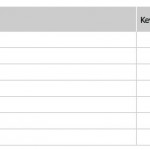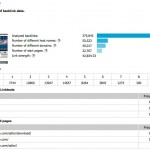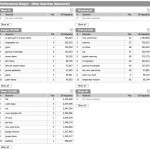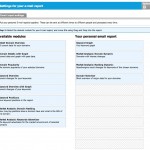Anyone practicing SEO professionally will quickly identify repetitive tasks and look for someone to take care of them. After all, painstakingly counting peas takes away from the actual, creative optimization work. But this “someone” doesn’t have to be an employee; in many cases it turns out to be the Searchmetrics Suite software. This software not only offers the standard “ad hoc” analyses, but also the necessary functions and tools to answer the questions that arise in the field of enterprise.

Monthly workflow for in-depth analysis and company-wide reporting
In the first part of this series on workflows in the business of SEO, we took a look at the weekly workflows used for Google optimization. These included, in particular, important subjects like the appearance, whether or not the SERPs spreading indicated a penalty, as well as operative tasks for optimizing individual keyword chances. In the second part we will focus on the “monthly general analysis”, meaning the repetitive tasks that ensure technical improvements over a four-week cycle, point out farther-reaching changes and provide the proper data for company reporting.
The following tasks have proven to be effective in a monthly cycle:
1. Technology check with the audit score

The on-site analysis by the Searchmetrics Suite software observes the most important technical and structural factors of a registered website. Of course, the gathered data still needs to be interpreted by the responsible technician or SEO. However, many of the recommendations regarding the IP address, image sizes, style sheets and other technical details, for example, are very precise.
And since the data is saved each month, improvements (and with luck no negative developments) can be easily observed.
2. Monthly rankings of keyword category positions, directories and spreading

While the weekly keyword position analysis serves the operative processing of chance keywords and movers and shakers, the monthly report focuses on a more in-depth position analysis. The Suite can answer questions very quickly relating to: the development of keyword categories (if they have been set up), directory analyses with respect to visibility (also for long tail analysis with the monthly Suite performance data) and, of course, a more in-depth observation of the various directories according to their visibility development and the respective important keywords.
This allows the SEO not only to gather information for the further optimization of the website, but also to recognize Google’s penalties, which are now only implemented on the directory level.
3. Backlink analysis

Since a good backlink setup is a long-term development process in and of itself, monthly controlling and adjusting in this area is often sufficient. It should then, however, be comprehensive.
Questions that should always be asked in this frequency of the Searchmetrics Suite software are: How has my link strength changed? Which URLs received the most links? What is the homepage deep link ratio? Which links have I lost (and can they be recovered)? And, of course, the backlinks should be checked at least once a month to make sure they are still up-to-date and to check if any adjustments need to be made. This, of course, also provides important inspiration for link development – for example, with regards to competitive links.
4. Directory and subdomain analysis

Once the data from the performance analysis and a table from the backlink analysis are available, the two should be combined. Sometimes small enterprise directories and subdomains can be as powerful as entire websites elsewhere. And they should be treated accordingly. It is very important to know if perhaps all new links are pointing to the company blog while there is still a need to increase the visibility of the store area in particular. This is something you need to know before you can make any adjustments or corrections.
This is just one example of the many opportunities that the Searchmetrics Suites software has to offer for the analysis of directories and subdomains. Since each website has its own unique architecture, a smart SEO should prepare his own method of working through the Suite data.
5. Market observation: What is the competition doing?

And once a month you should stop just studying your navel – and look at what the competition is doing. This is, of course, very easy with regards to all the functions that allow a domain to be registered. From the audit score to the number of pages in the index and, of course, all the links: see everything without a lot of searching.
It is, however, also important to look for new competition. The Searchmetrics Sujte market observation function lets you find pages that are very strong with regards to the defined keyword set. And not only that: This is where you can see which sites are up and coming. And as everyone knows, those can prove to be the toughest competitors in the future.
6. Universal Search: Seize opportunity with images, videos and shopping

With the monthly performance data from the long tail analysis, in which more than 25 million keywords and more than 50 million domains are observed, you can make a very in-depth analysis of vertical searches and their chances in the universal search. And you should. Anyone with a lot of images in their index of which only a few are being found is wasting capital.
In this sense, maps, shopping, images, videos and news offer different, but very significant potential assets that can be valuable when taking a look at any area. My recommendation: perform an in-depth analysis of at least one vertical search each month and take concrete optimization measures the following week.
7. Gathering KPIs and Reporting

Even if we SEOs wish things were different: most companies do monthly reports instead of weekly reports. That’s why part of the job is preparing a report for management and the other departments each month. This can be done very quickly using the Searchmetrics Suite reporting module. But the time you save with it shouldn’t spent in the cafeteria or doing other things.
I strongly recommend that the time saved through the automation of the reporting process be spent on editorial reporting: What changed in the last month? How should the numbers be interpreted? Which competitors do we need to keep an eye on? This is what will earn you the attention within the company that a SEO deserves.
And how long does this take?
To wrap things up, let’s address the question regarding the amount of time to devote to this monthly analysis. Once again, the answer cannot be precisely defined. There are many reasons why the monthly general analysis can take a long – if not a very long – time. Especially when you always jump from the analysis straight to the operative optimization. For example, if you find a lost link at a partner company during the backlink analysis, it can be very tempting to immediately pick up the phone. This is something you can do, but it will turn your monthly analysis into a month(s) long analysis.
If you can reduce the time to the actual analysis work (and if the Searchmetrics Suite software is properly prepared), the general analysis will only last a few hours, or maybe a day at most. But certainly no longer than that. And as a professional SEO, it is time well taken …
P.S.: Who’s writing this stuff? My name is Eric Kubitz and I am one of the co-founders of CONTENTmanufaktur GmbH [fuzzy] Anyone trying to reach me can do so via e-mail (ek@contentmanufaktur.net), Twitter, or G+… ‘Til next time!